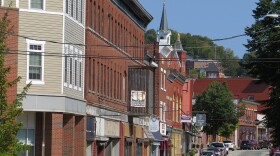Isaac Poe knew things were moving in the wrong direction when he saw his neighbor make a last-ditch effort to clear the water that was rising quickly around their houses.
“He actually thought he might help it out by going over there with a snowblower to move the water along,” Poe recounted Friday. “You know, the Yankee ingenuity part of things.”
In the ensuing hours, raging waters converged on Poe’s home in St. Johnsbury from multiple directions.
“It bore a hole in the basement under the porch here, and we had a foot-solid block of water coming in until the basement was all but a foot and a half full,” Poe said.
The water upended a fuel tank in the basement.
“So we have a sheen of heating oil on top of the water,” he said.
And Poe, who lives there with his wife and two dogs, is bracing for a rough few weeks.
“The magnitude of what happened and what it means now? We have a lot of work ahead of us,” he said.
But the Poes have flood insurance. And they feel optimistic about their future here, despite the setback.
“Oh certainly — this is our home, yeah,” Poe said.
“The magnitude of what happened and what it means now? We have a lot of work ahead of us.”Isaac Poe, St. Johnsbury resident
The Passumpsic River in the Northeast Kingdom got its name from the Abenaki word for clear, sandy bottom. Last week, heavy rains turned that water into a dark brown torrent that flooded several Caledonia County towns built on its banks.
Many residents whose homes got inundated Thursday morning, such as the Poes', now face an arduous recovery process.
Some Northeast Kingdom residents, however, will never live in their homes again. Those who are permanently displaced include Richard Hall and June Brill-Hall, who live in Lyndonville.
“We can’t afford flood insurance,” Brill-Hall said. “It’s over $1,200 a year. We can’t afford it.”
The Halls’ home, which they recently redid, appears to be a total loss.
“I put about $20,000 into it,” Richard Hall said. “Now it’s gone.”
The couple, both in their 70s, was pondering next steps at a makeshift shelter at the Lyndonville Fire Department this weekend. They said they don’t have any answers yet, including where they’re going to live.
“Don’t know nothing,” Richard Hall said. “Don’t know where we’re going yet.”

Northeast Kingdom towns including Barnet, Peacham, St. Johnsbury, Hardwick and Lunenburg all saw major flooding last week. There’s no official tally yet for how many residences were damaged or destroyed. But dozens of people in Lyndonville alone saw water crest their ground floor.
Bruce Appleby had to force his way past his trailer’s already warping door when he returned to his house for the first time since he was evacuated by boat Thursday morning.
“That don’t look good at all,” he said when he finally gained entry.
A thin layer of greasy silt covered the floor. Appleby assessed the damage around him in silence. He’s been through three major floods since he moved here 22 years ago.
“Ain’t the first time and it probably won’t be the last,” he said. “You just gotta deal with it and what comes and what goes.”


Whether it’s advisable or not, Appleby said he plans to stay put. He said he has no other choice.
“I always wanted to buy a piece of land, but I never could get a steady enough job to keep it and retire from it and buy me a piece of land on the tallest mountain I could find, and I wouldn’t have to worry about high water,” he said.
More from Vermont Public: How to help Vermont communities reeling from July 2024 floods
About a mile away, in another residential section of Lyndonville, Al Adams was pumping water from the basement of the large two-story home he and his wife have lived in for the past 30 years.
“This time it’s somewhere around a foot in the first floor,” Adams said. “Nasty.”

Like Appleby and the Halls and so many other residents in Lyndonville, Adams is no stranger to floods. But he hasn’t seen anything like this before.
“We got to experience our first … swift-water rescue,” he said.
Adams and his wife have mucked out and made do in the past. They’re ready to be done with the place now. They’re hoping for a payout from their flood insurance company. Even if they get one, however, it doesn’t necessarily solve their problem.
“I’m not sure where we would go. There’s no housing. My wife and I are in our early 70s, and we have this huge house, and it’s just a burden. And there’s no place to go.”Al Adams, Lyndonville resident
“I’m not sure where we would go. There’s no housing,” he said. “My wife and I are in our early 70s, and we have this huge house, and it’s just a burden. And there’s no place to go.”
On Saturday, Gov. Phil Scott asked the Federal Emergency Management Agency for a preliminary damage assessment, to determine if last week’s floods qualify for a major disaster declaration.
But as so many flood survivors discovered after last year’s disaster, FEMA’s individual assistance program often falls far short of what survivors need to rebuild their lives.
Have questions, comments or tips? Send us a message.
_





